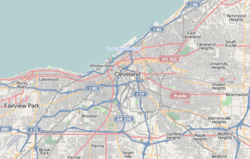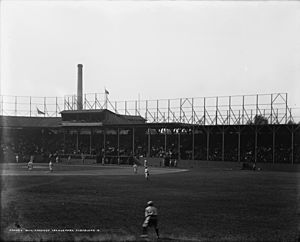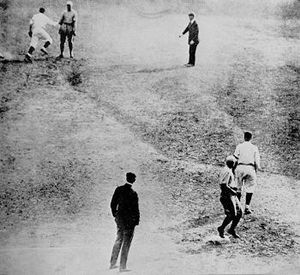League Park facts for kids
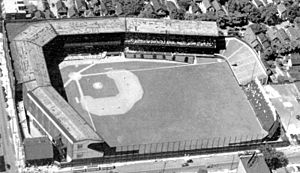
League Park from the air
|
|
| Former names | Dunn Field (1921–1927) |
|---|---|
| Location | East 66th Street & Lexington Ave. Cleveland, Ohio, United States |
| Coordinates | 41°30′41″N 81°38′39″W / 41.51139°N 81.64417°W |
| Capacity | 9,000 (1891) 21,414 (1910) 22,500 (final) |
| Field size | Left field – 375 ft (114 m) Left-center – 415 ft (127 m) Deep center – 460 ft (140 m) Center field – 420 ft (128 m) Right-center – 340 ft (104 m) Right field – 290 ft (88 m) |
| Surface | Grass |
| Construction | |
| Broke ground | 1891 |
| Opened | May 1, 1891 |
| Renovated | April 21, 1910 |
| Closed | September 21, 1946 |
| Demolished | 1951 |
| Architect | Osborn Engineering Company (1910) |
| Tenants | |
| Cleveland Spiders (NL) 1891–1899 Cleveland Lake Shores (WL) 1900 Cleveland Indians (MLB) 1901–1932, 1934–1946 Cleveland Bearcats / Spiders (AA) 1914–1915 Cleveland Red Sox (NNL II) 1934 Cleveland Bears (NAL) 1939–1940 Cleveland Buckeyes (NAL) 1942–1950 Cleveland Tigers (OL/NFL) 1916–1922 |
|
|
League Park
|
|
| Location | Lexington Ave. and E. 66th St., Cleveland, Ohio |
| Area | 1 acre (0.40 ha) |
| Built | 1891, 1909–1910 |
| Architect | Charles S. Schneider |
| NRHP reference No. | 79001808 |
| Added to NRHP | August 8, 1979 |
League Park was a famous baseball park in Cleveland, Ohio, United States. It was located at East 66th Street and Lexington Avenue. This historic park was first built in 1891 with wood. Later, it was rebuilt in 1910 using concrete and steel.
Many professional sports teams called League Park home. The Cleveland Indians of Major League Baseball played there for many years. Before them, the Cleveland Spiders played there from 1891 to 1899. In the 1940s, the Cleveland Buckeyes of the Negro American League also played their games at League Park.
Besides baseball, League Park was also a big place for American football. Several early National Football League (NFL) teams used it, including the Cleveland Rams. College football teams, like the Western Reserve Red Cats, also played many important games there.
Even after the much larger Cleveland Stadium opened in 1932, League Park was still used. The Indians played their weekday games there until 1946. Most of League Park was torn down in 1951. However, some parts, like the original ticket office, still stand today. In 2014, the site was reopened as the Baseball Heritage Museum and Fannie Lewis Community Park.
Contents
History of League Park
League Park was built for the Cleveland Spiders baseball team. The team's owner, Frank Robison, chose the spot because it was on a streetcar line he owned. The park first opened on May 1, 1891. It had 9,000 wooden seats. The Spiders won their first game there, 12–3, with Cy Young pitching.
The Spiders were a good team for a while, even winning a championship called the 1895 Temple Cup in 1895. But in 1899, the team lost its best players. They had a terrible season, winning only 20 games and losing 134. So few fans came to their games that other teams didn't want to travel to Cleveland. The Spiders team was then removed from the league.
Rebuilding and New Teams
The park was completely rebuilt for the 1910 season. It became a modern stadium made of concrete and steel. The new park could hold over 18,000 people, more than double its original size. It opened on April 21, 1910.
From 1914 to 1915, a minor league team called the Toledo Mud Hens played at League Park. They were called the Cleveland Bearcats and then the Cleveland Spiders during this time. This was done to stop another league from starting a team in Cleveland.
The Cleveland Indians played games four through seven of the 1920 World Series at League Park. The Indians won the series, which was their first championship ever. Game five was especially famous for two "firsts" in World Series history. It had the first grand slam and the only unassisted triple play.
In 1921, the park's owner, Jim Dunn, renamed it Dunn Field. After he passed away, his wife inherited the park. When she sold the team in 1927, the name went back to "League Park."
Sharing with Cleveland Stadium
From 1932 to 1933, the Indians played at the new, much larger Cleveland Stadium. However, players and fans didn't like the huge outfield, which made home runs harder to hit. Also, during the Great Depression, not many people came to the stadium.
So, the Indians returned to League Park for the 1934 season. Starting in 1937, they began to split their games between the two parks. Sunday and holiday games, which drew bigger crowds, were played at Cleveland Stadium. Weekday games stayed at League Park.
League Park never had permanent lights, so no major league night games were played there. The last Indians game at League Park was on September 21, 1946. It was a 5–3 loss to the Detroit Tigers. After this, the Indians played all their home games at Cleveland Stadium.
The city of Cleveland bought League Park in 1950. Most of the stadium was torn down in 1951. This was to make space for local amateur sports and recreation. The Cleveland Browns football team used the field for practice until 1965.
Park Structure and Design
When League Park first opened in 1891, it had 9,000 wooden seats. There was a main grandstand behind home plate and bleachers in other areas. The field was shaped to fit the city streets, making its dimensions a bit unusual. The left field fence was 385 feet away, center field was 460 feet, and right field was 290 feet. Batters had to hit the ball over a 40-foot-high fence for a home run.
The park was almost completely rebuilt before the 1910 season. It then had concrete and steel double-decker grandstands. This expanded the seating to over 21,000 people. The design was done by Osborn Architects & Engineers. This company also designed other famous ballparks like Fenway Park.
The new design brought the upper deck seats closer to the action. The outfield fences were also changed. Left field was 375 feet away, and center field was 420 feet. Right field stayed at 290 feet. The tall 40-foot fence for home runs remained a challenge for batters.
League Park Today
Today, the site of League Park is a public park. A small part of the original brick wall from the first-base side still stands. The old ticket office, built in 1909, is also still there. Youth teams from local schools still play baseball on the field.
In 2011, the Cleveland City Council approved a plan to restore the ticket house and the remaining wall. They also planned to build a new baseball diamond in the same spot. The restoration project began in 2012. It included a museum, a restored ball field, and a community park with walking trails. The community park was named the Fannie M. Lewis Community Park in 2013. Fannie Lewis was a city councilwoman who supported the park's restoration.
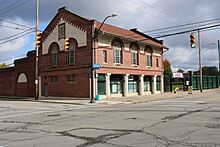
The restoration was finished in 2014, and League Park reopened on August 23 of that year. The Baseball Heritage Museum moved into the restored ticket house. It displays items from baseball history, especially those related to League Park.
Memorable Moments at League Park
Many exciting events happened at League Park:
- May 1, 1891: The park opened. Cy Young threw the first pitch, and the Spiders won 12–3.
- October 17–19, 1892: The park hosted the first three games of the National League's "split season" series.
- October 2, 1908: Addie Joss pitched a perfect game against the Chicago White Sox. This means no batter reached base.
- October 10, 1920: Game 5 of the 1920 World Series saw several "firsts":
- Cleveland's Elmer Smith hit the first grand slam home run in World Series history.
- Cleveland pitcher Jim Bagby hit the first home run by a pitcher in a World Series game.
- Cleveland second baseman Bill Wambsganss made the only unassisted triple play in World Series history.
- October 12, 1920: The Cleveland Indians won their first World Series championship.
- August 11, 1929: Babe Ruth hit his 500th career home run here. He was the first player to reach this amazing milestone.
- July 16, 1941: This was the final game of Joe DiMaggio's incredible 56-game hitting streak.
- 1945: The Cleveland Buckeyes won the 1945 Negro World Series.
- September 21, 1946: The last Major League Baseball game was played at League Park.
- November 24, 1949: The final college football game was played, with Western Reserve beating Case Tech 30–0.
Images for kids
-
Thanksgiving Day college football game between Western Reserve and Case, 1896.


